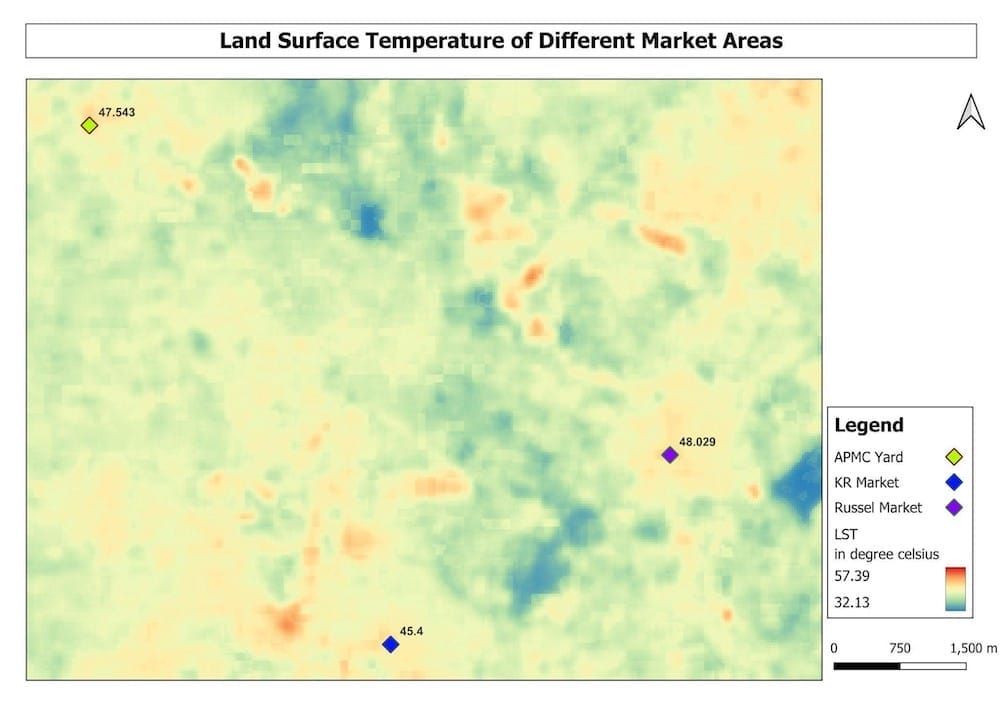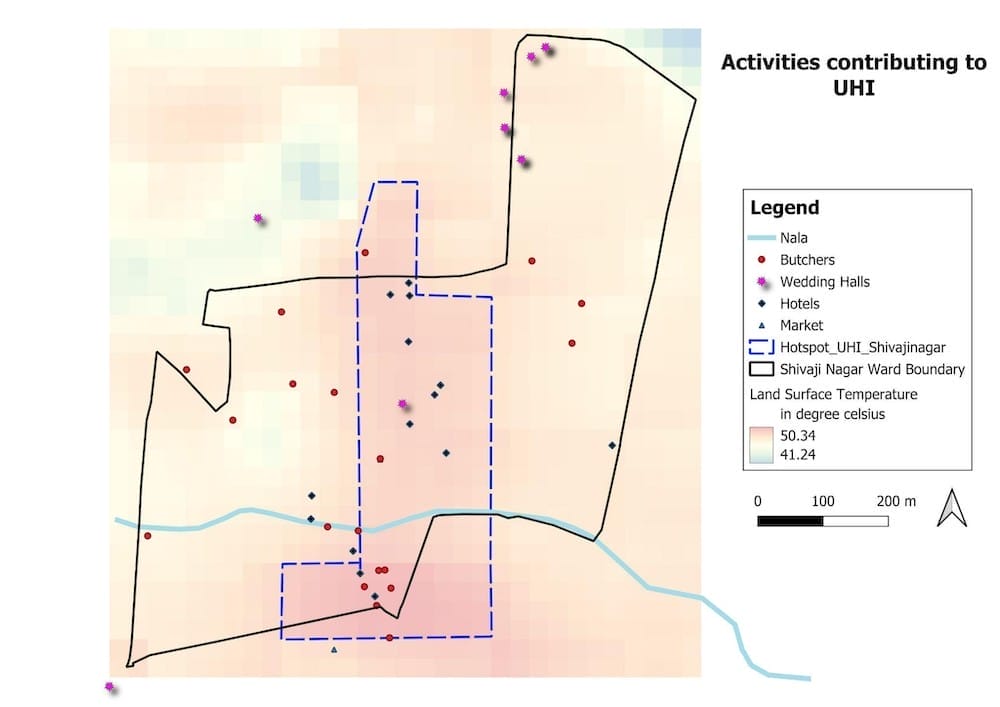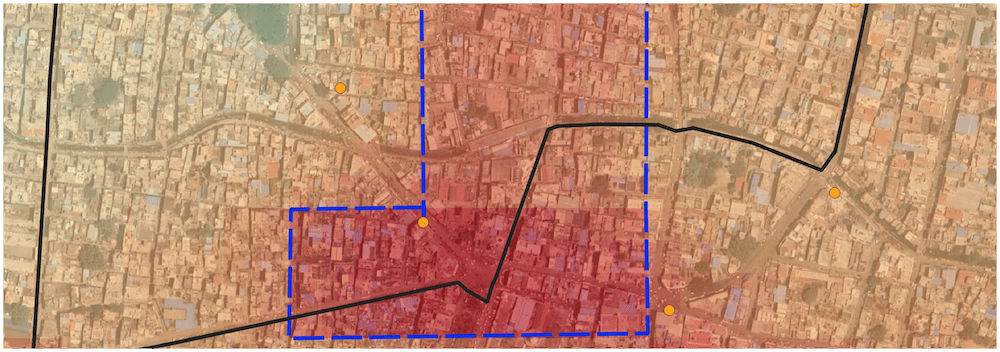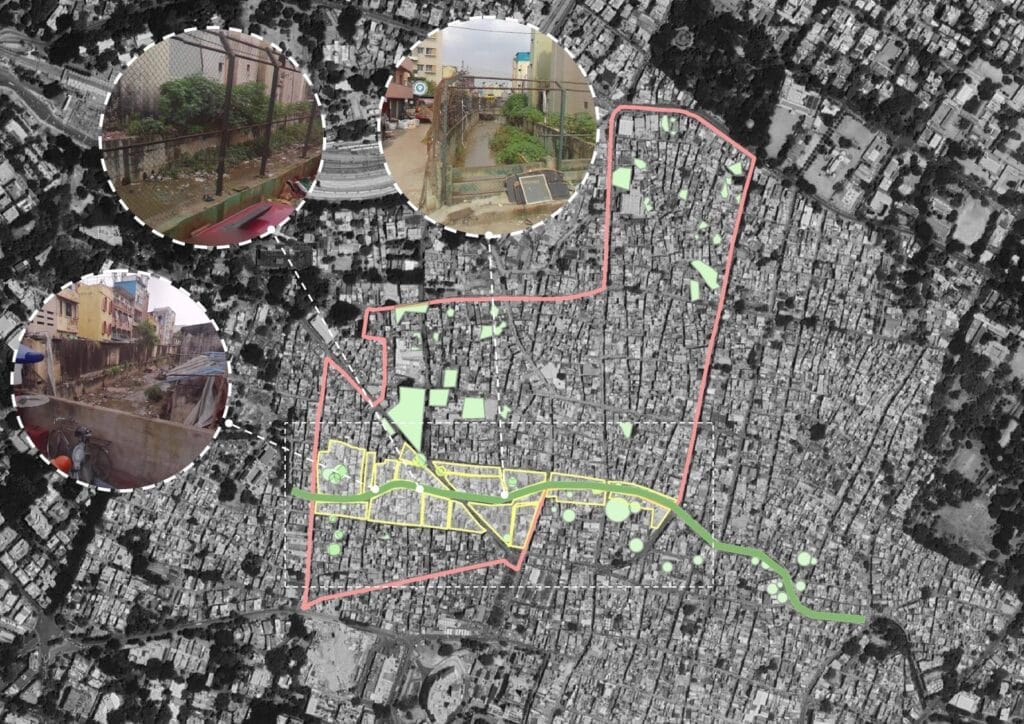Urban Heat Islands (UHI) are areas within cities that experience significantly higher temperatures than their rural counterparts due to human activities, concretisation, and lack of vegetation. Bengaluru, the fifth most populous metropolis (Census of India, 2011) and one of the rapidly growing cities in India, is no exception.
In the last two decades, the city has seen a rapid rise in built-up area from 37.4% to 93.3%. The pressure of urbanisation has not only affected the natural and ecological resources but is also impacting the city’s livability because of rising temperature levels. Unlike sudden disaster events like landslides or floods, which have visible effects, extreme heat in urban areas occurs slowly. However, it has long-lasting effects, which can inform economic and social vulnerabilities at a larger scale. Much like other disasters, the economically and socially vulnerable communities bear the brunt of its impact.
In recent years, the impact of UHIs has become more prominent in the city, especially in dense commercial areas. Our study examined the Urban Heat Island (UHI) effect in Shivaji Nagar’s Russell Market and also compared the same with other major commercial areas in the city, such as KR Market and APMC Yard. These markets not only attract high footfall but also contribute to extreme heat, affecting workers, commuters and residents.
Read more: From industrial boom to heat doom: Peenya’s struggle with rising urban temperature
Heat analysis of Bengaluru’s markets
For our study, we used land surface temperature (LST) data, which was derived from LANDSAT (information from satellites) data using Google Earth Engine and also mapped locations using Google Earth Pro. The LANDSAT data for this analysis was collected for April 2024, and the data analysis revealed that in Shivaji Nagar ward, temperatures reached an average of 47°C, particularly near Russell Market, with most areas recording above 45°C.
Similar trends were observed in other markets, such as the KR Market and APMC Yard, due to common factors like high foot traffic and minimal green cover. These markets, characterised by their dense commercial activities, concretised surfaces, and lack of ventilation, exacerbate UHI effects.



Water bodies contributing to the UHI
Healthy water bodies naturally reduce surrounding heat due to their high heat capacity and ability to cool through evaporation, especially during summer. This helps lower the UHI effect. Interestingly, the nala (stream) running through Shivaji Nagar, instead of cooling the area, caused higher temperatures.


Possible reasons for this phenomena could be
- Low water levels during summer and heat emitted from concretised beds.
- Methane emission due to decaying organic content from garbage and sewage.
Methane, being a potent greenhouse gas, traps significantly more heat in the atmosphere.
Key factors contributing to UHIs in markets:
- Concretised surfaces: Markets are built with materials like concrete and asphalt, which absorb and retain heat, amplifying surface temperatures.
- Foot traffic and vehicular congestion: The high volume of people and vehicles further elevates temperatures, trapping heat in already overheated areas.
- Lack of green cover: These market zones have little to no vegetation, eliminating the cooling benefits of trees and greenery.
- Mixed land use: Areas like Shivajinagar combine commercial, residential, and industrial zones, intensifying heat accumulation due to various ongoing activities.
Read more: Heat wave information: What to look out for and where?
Way forward for UHI in Bengaluru: Addressing key challenges
Short-term solutions: To combat the rising temperatures, several immediate interventions can be implemented:
- Heat insurance: Inspired by initiatives in Rajkot, SEWA’s heat insurance provides financial support to help vulnerable populations access cooling measures and medical aid before heat waves peak.
- Cooling centres: Establishing temporary cooling centres, such as shaded areas with fans, can provide relief during peak summer hours. These centres can be set up in metro stations, malls, or government buildings.
- Water kiosks and ORS centres: Ensuring free access to drinking water and Oral Rehydration Salt (ORS) centres in high-traffic areas will help prevent heat stress.
- Temporary shade structures: Installing mesh nets or temporary shading at traffic signals can provide relief for commuters, especially those traveling by two-wheelers or on foot.
- Medical standby: Positioning ambulances or medical camps in high-heat zones during peak seasons will offer immediate support for heat-related illnesses.
Long-term strategies: Addressing UHIs in the long term requires structural changes and policy support:
- Ward level analysis: Identifying hotspots in every ward helps in building a database of people and critical infrastructure which have a high degree of exposure to the hazards and also assesses their vulnerability and coping adaptability towards the hazards. This not only helps in building capacity but also in deploying targeted help in these vulnerable areas.
- Building retrofitting: Identifying vulnerable structures, such as those with asbestos or tin roofs, and retrofitting them to reduce heat retention can significantly improve working conditions.
- Indoor thermal heat comfort assessment: While remote sensing and heat simulations provide insights into heat gains across urban areas, detailed neighbourhood- and street-level data remain lacking, even though they are critical for understanding thermal comfort and its varied socio-economic impacts. Building typology, including form and material, plays a key role in heat gain. Installing Automated Weather Stations (AWS) and IoT-based heat monitoring systems can bridge this gap by generating long-term, real-time data, enabling more precise mitigation strategies and informed urban design.
- Cool roof policies: Governments should mandate cool roofs for buildings in vulnerable areas. These roofs reflect more sunlight and absorb less heat, reducing indoor temperatures.
- Vertical gardens and green spaces: Incorporating vertical gardens or green roofs, where feasible, can help cool dense market areas. Even small patches of greenery can have a meaningful impact on reducing temperatures.
- Shade policies: Developing shade policies that ensure walkways, bus stops, and market areas have adequate shading will help reduce direct exposure to the sun. This can include planting trees or installing structural shading where planting is not possible.
While short-term solutions like cooling centres and water kiosks can provide relief, long-term strategies such as green infrastructure, cool roofs, and shade policies must be implemented to ensure sustainable urban development. Collaborative efforts between local governments, market vendors, and residents are crucial to making these areas more livable in the face of increasing temperatures.
[This is part of the insights generated from OpenCity’s Urban Heat Data Jam.]